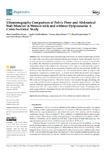Ultrasonography Comparison of Pelvic Floor and Abdominal Wall Muscles in Women with and without Dyspareunia: A Cross-Sectional Study

Use this link to cite
http://hdl.handle.net/2183/32440Collections
- Investigación (FEP) [507]
Metadata
Show full item recordTitle
Ultrasonography Comparison of Pelvic Floor and Abdominal Wall Muscles in Women with and without Dyspareunia: A Cross-Sectional StudyAuthor(s)
Date
2022-07Citation
Castellanos-López, E.; Castillo-Merino, C.; Abuín-Porras, V.; López-López, D.; Romero-Morales, C. Ultrasonography Comparison of Pelvic Floor and Abdominal Wall Muscles in Women with and without Dyspareunia: A Cross-Sectional Study. Diagnostics 2022, 12, 1827. https://doi.org/10.3390/diagnostics12081827
Abstract
[Abstract] Pelvic floor hypertonicity and narrowing of the levator ani hiatus is traditionally assumed
in women with dyspareunia and considered a therapeutical target by physical therapists. However,
accurate pre-treatment assessment of pelvic floor muscles is difficult to perform in clinical sites.
In addition, the abdominal musculature has not been evaluated in this population, despite its
relationship with pelvic floor disfunctions. The purpose of this study was to determine the existence
of differences in the length of the anteroposterior diameter of the levator ani hiatus (APDH), the
thickness of the abdominal wall musculature and the interrecti distance (IRD) in subjects with
dyspareunia compared to a control group. A cross-sectional observational study was designed
using ultrasound imaging to measure the APH, the thickness of the abdominal musculature—rectus
abdominis (RA), transverse abdominis (TrAb), internal oblique (IO), external oblique (EO)—and
IRD at rest and during contraction. Thirty-two women were recruited through advertising and
social webs and divided into two groups: dyspareunia (n = 16) and no dyspareunia (n = 16). There
were no statistically significant differences (p < 0.05) in RA, TrAb, OI and OE muscle thickness. No
differences in APH or in supraumbilical and infraumbilical IRD were found. The findings of this
study suggest that the relationship between the abdominal structure/levator ani hypertonia and
dyspareunia remains uncertain.
Keywords
Physiotherapy
Fisioterapia
Dyspareunia
Dispareunia
Pelvic floor
Suelo pélvico
Abdominal muscles
Músculos abdominales
Ultrasound
Ultrasonidos
Fisioterapia
Dyspareunia
Dispareunia
Pelvic floor
Suelo pélvico
Abdominal muscles
Músculos abdominales
Ultrasound
Ultrasonidos
Editor version
Rights
Atribución 3.0 España






